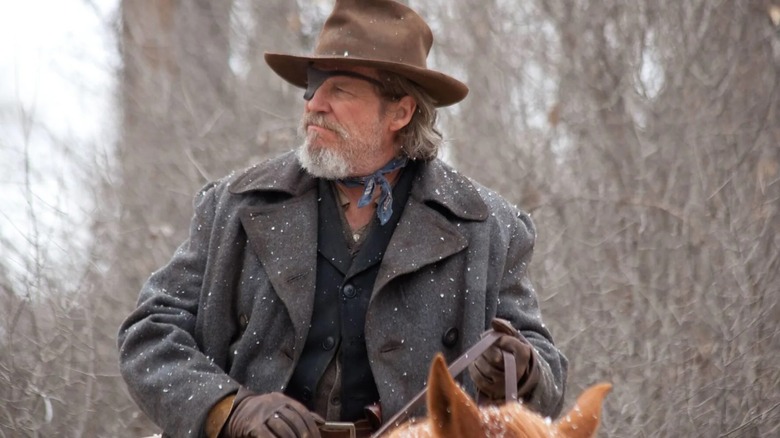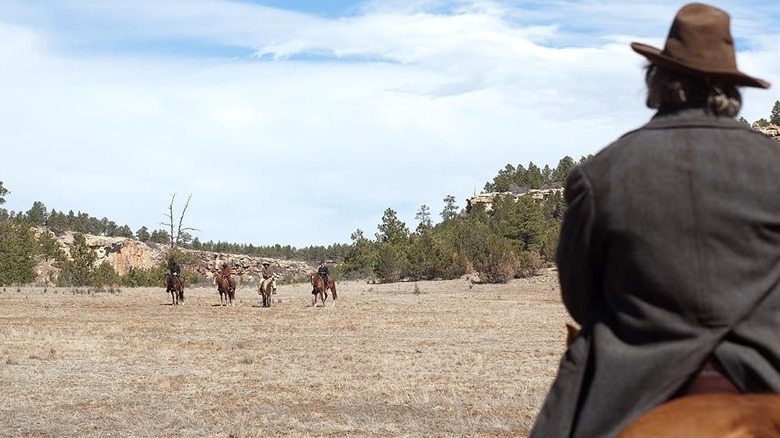Jeff Bridges Dangerously One-Upped John Wayne In One Of True Grit's Best Scenes
Charles Portis' novel "True Grit" has been brought to life on the big screen several times, but Henry Hathaway's 1969 John Wayne-starring adaptation is perhaps the most popular. Wayne's rendition of Rooster Cogburn is one of his most-recognized late-period roles, and it also earned him an Academy Award for Best Actor — an accolade that feels thoroughly deserving due to the actor's ability to seamlessly inhabit the plucky, one-eyed U.S. Marshal. Portis' "True Grit" is told from the perspective of the adolescent Mattie Ross, whose deadpan, no-nonsense demeanor is our portal to the treacherous grown-ups around her, and her bond with the tough-as-nails marshal soon emerges as the heart of the drama. Wayne expertly balances Rooster's more vicious sensibilities with the hidden vulnerabilities that emerge when he helps Mattie exact revenge and looks endlessly cool while charging toward armed dudes with dual guns on horseback.
Although no one can replicate the cool factor that Wayne injected into Rooster, Jeff Bridges, who embodied Rooster in Ethan and Joel Coen's 2010 "True Grit," came extremely close. For starters, the Coens did not approach "True Grit" as a remake of Hathaway's film, but as a faithful adaptation of Portis' novel, with a focus on the more violent overtones that got diluted in the 1969 version. As a result, the film retains the bleakness of the original narrative. Bridges' Rooster is decidedly more violent when he pursues fugitives and troublemakers for a living. Even when he expresses concern for Mattie (Hailee Steinfeld), there's a sense of detachment amidst the vulnerability, and the bursts of cruelty that define his personality feel sharper than Wayne's version, which is easier to root for.
Nevertheless, when it came to displaying true grit, Bridges participated in a dangerous stunt during the film's climax, evoking yet another contrast with Wayne's version.
Jeff Bridges took some risks with his True Grit character
The climactic scene where Rooster charges into battle, guns blazing, with the reins of his horse between his teeth, is considered iconic, especially with Wayne setting the dramatic precedent. It was complicated to shoot, which explains why Hathaway shot the scene with Wayne on a moving truck as opposed to an actual horse. The Coens acknowledged the risks taken by an actor accomplishing this the traditional way, which Bridges did, and quite well. As they told MTV in 2010:
"You have to be a really, really good rider to do that and even if you are a good rider, you have to have the right terrain, the right horse, and all the rest of it [...] You didn't actually see it that way in the original movie, so there were things that Jeff had to do that were really difficult to accomplish. But it was also a very complicated scene in terms of coverage. There were scenes that [cinematographer] Roger [Deakins] had to do in terms of actually being able to physically shoot this stuff on uneven terrain [...]"
In a 2011 interview with The Hollywood Reporter, Ethan Coen joked that "our Rooster could take their Rooster" (referring to Wayne's character), while Joel Coen reiterated the difficulty inherent in the dangerous stunt:
"That was something we — and even Jeff — assumed would have to be fudged in one way or another, but he actually did all that for real. It was really quite difficult, manipulating those two big heavy guns with the reins in his teeth without being able to control the horse except with his legs."
Kudos to Bridges for bringing such an authentic feat to life and staying loyal to the essence of "True Grit," a story that remains audacious in its treatment of established genre themes.

